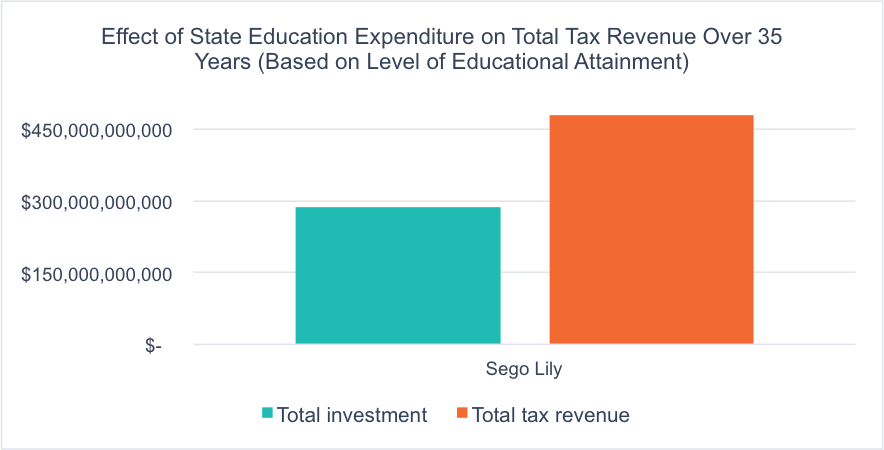The Story
Investment in education increases significantly and is consistent and stable. The state budget for education increases 5% per year until 2020. Although it is likely that projected growth for Utah’s economy and tax revenues could fund at least a 3.4% increase per year, and potentially all of this 5% increase, it may require reallocating money from other purposes in the state budget or an increase in taxes, at least in the short term until higher education levels increase incomes and therefore tax revenues. After 2020, funding keeps up with student growth and inflation. This money is targeted to specific, highly-leveraged strategies to improve performance.We adopt a long-range plan to improve the education and employment opportunities for all citizens and provide the funding and resources needed to achieve the plan. Utah education helps most students perform at grade level by continually reviewing and implementing rigorous standards and ongoing assessments of progress and by providing individual assistance to those at risk of falling behind. Parents and families are highly involved in their children’s education. Overall, education is characterized by:
- Improved student-to-teacher ratios.
- Significant improvement in teacher compensation, training, and professional development.
- Increased investment in high-quality early childhood education for at-risk students and voluntary all-day kindergarten.
- Investment in targeted programs to improve reading and math skills.
- Increased collaboration among schools, community partners, and families.
- Investment in technology combined with a strategic approach and proper teacher training.
- Improved capacity and resources in higher education institutions to help students complete degree programs.
In addition, schools become community centers that provide other services to Utahns, including adult education, health services, and job skills training. Affordable tuition and increased resources of higher education institutions help more students enter into and complete certificate and degree programs. Because of its proactive and aggressive approach to providing quality education, Utah becomes one of the top ten states for academic performance. Utah’s workforce is highly educated and attracts high-quality jobs to the state. Median wages and tax revenue increase, and the number of Utahns requiring social services and assistance decreases substantially.
Results
- Number of students functioning at grade level and meeting testing standards significantly increases.
- Percent of people graduating from high school and higher education is substantially higher than today.
- 90% of high school students graduate.
- 66% of all Utahns have a post-secondary certificate or degree.
- All students have access to high-quality educational resources and opportunities.




Background
The benefits of education extend beyond individual students. Having an educated population leads to a better quality of life across the entire state. Those with post-secondary education particularly have higher earning potential and better job prospects and tend to be more civically engaged through voting and volunteering. They also tend to be healthier and have a high quality of life and are much less likely to be incarcerated. Furthermore, an educated populace leads to a reduction in crime and the need for social services (e.g., food stamps, unemployment benefits, etc.) and attracts innovation, which leads to a robust economy.
A number of education strategies may substantially impact students’ educational success. Voluntary high-quality preschool and all-day kindergarten programs, particularly for children at risk of falling behind their peers, raise educational performance, increase cognitive gains, and improve social skills. Rigorous standards, ongoing assessments of math and reading skills, and targeted interventions help ensure students become college and career ready. In addition, active involvement from parents and families in a child’s education can significantly improve that child's achievement.
Though many educational performance indicators in Utah are improving, they are dropping in comparison to other places in and outside the United States where educational improvements are being implemented faster. In Utah, not enough students are graduating from high school or from higher education institutions to meet the needs of future employers.
The largest portion of education funding comes from state income taxes, followed by property taxes, some federal taxes, and other sources. Like many states, Utah’s per-student public education funding declined significantly during the recession. That trend has reversed and the governor and legislature have improved funding for education, though we have not quite yet returned to pre-recession state funding levels. The investment we make in education in the next few years could have a significant impact on Utahns and our economy over the next thirty-five years.
The national economy is changing, and more jobs now require degrees or certification beyond high school. To be competitive in a global economy, Utah will need a highly-educated populace.
Note: The tax expenditure and revenue analysis is based on the assumption that in certain scenarios, more people receive diplomas, certificates, and degrees, and therefore earn higher wages and pay more taxes. Tax revenue is based on from the median earnings by educational attainment (no high school, high school diploma, certificate/associate’s degree, bachelor’s degree, or graduate/professional degree), similar to a study conducted by the Utah System of Higher Education. An economic multiplier of 20% was included to estimate the impact of higher wages on the economy.


